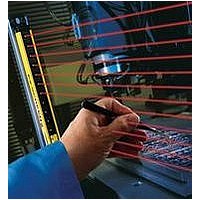IM-T-11A BANNER ENGINEERING, IM-T-11A Datasheet - Page 8

IM-T-11A
Manufacturer Part Number
IM-T-11A
Description
Interfacing Module
Manufacturer
BANNER ENGINEERING
Datasheet
1.IM-T-11A.pdf
(12 pages)
Specifications of IM-T-11A
Supply Voltage Max
24VDC
Control Output Type
2NO/1NC
External Device Monitoring
To satisfy the requirements of Control Reliability (OSHA and ANSI), Category 3 and 4 of ISO
13849-1 (EN 954-1), the Machine Primary Control Elements (MPCEs) must each offer a
normally closed, forced-guided (mechanically linked) monitor contact. Connect one normally
closed monitor contact from each Machine Primary Control Elements as shown in the
Overvoltage Category II and III Installations (EN 50178 and IEC 60664-1)
The Interface Module is rated for Overvoltage Category III when voltages of 1V to 150V ac/dc
are applied to the output relay contacts. It is rated for Overvoltage Category II when voltages
of 151V to 250V ac/dc are applied to the output relay contacts and no additional precautions
Auxiliary Monitor Contact (Model IM-T-11A Only)
The action of the auxiliary monitor contact, terminals 31-32, inversely "follows" the action of the
safety outputs. The 31-32 auxiliary monitor contact is to be used only for control functions that
are NOT safety-related. A typical use is to communicate the status of the Safety Module output
8
appropriate hookup drawing (figures 4 through 8).
In operation, if one of the switching contacts of either MPCE fails in the energized condition,
the associated monitor contact will remain open. Therefore, it will not be possible to reset
the primary safety device. If no MPCE-monitor contacts are monitored, it is the user's
responsibility to ensure that any single failure will not result in a hazardous condition
and will prevent a successive machine cycle.
are taken to attenuate possible overvoltage situations in the supply voltage. The Module
can be used in an Overvoltage Category III environment (with voltages of 151V to 250V ac/
dc) if care is taken either to reduce the level of electrical disturbances seen by the Module to
Overvoltage Category II levels by installing surge suppressor devices (e.g., arc suppressors),
or to install extra external insulation in order to isolate both the Interface Module and the user
from the higher voltage levels of a Category III environment.
For Overvoltage Category III installations with output contact voltage 151V to 250V ac/
dc applied to the output contact(s): the Interface Module may be used under the conditions
of a higher overvoltage category where appropriate overvoltage reduction is provided.
Appropriate methods include:
• An overvoltage protective device
• A transformer with isolated windings
• A distribution system with multiple branch circuits (capable of diverting energy of surges)
• A capacitance capable of absorbing energy of surges
• A resistance or similar damping device capable of dissipating the energy of surges
to a programmable logic controller (PLC).
Many types of mechanisms are used to arrest dangerous machine motion. Examples include
mechanical braking systems, clutch mechanisms, and combinations of brakes and clutches.
Additionally, control of the arresting scheme may be hydraulic or pneumatic. As a result,
an MPCE may be one of several control types, including a wide variety of contactors and
electromechanical valves. If your machine documentation leaves any doubt about the proper
connection points for the Interface Module output contacts, do not make any connections.
Contact the machine builder for clarification regarding connection to the MPCEs.
Two-Channel Control (Figures 4, 5, 6 and 7): Two-channel control allows the Primary Safety
Device to detect an unsafe failure of the control wires. Two-channel control should be used
whenever unsafe failure of the control wires cannot be eliminated.
The outputs of the primary safety device must at minimum, comply with the requirements
described on page 5. These outputs must be monitored for failure by the primary
safety device. In addition, a single output failure cannot prevent normal stopping action, and a
successive cycle cannot be initiated until the failure has been corrected.
P/N 62822 rev. C
– Interface Modules
– Interface Modules
Banner Engineering Corp.
Banner Engineering Corp.
www.bannerengineering.com • Tel: 763.544.3164
www.bannerengineering.com • Tel: 763.544.3164
NOTICE regarding MPCEs
To achieve control reliability, two
Machine Primary Control Elements
(MPCEs) are required to control each
machine hazard. Each MPCE must be
capable of immediately stopping the
dangerous machine motion, irrespective
of the state of the other. Some
machines offer only one primary control
element. For such machines, it is
necessary to duplicate the circuit of the
single MPCE to add a second MPCE.
MPCEs must offer at least one forced-
guided auxiliary contact which is wired
to the monitoring contact feedback
input of the primary safety device (see
hookup diagrams).
NEVER wire any intermediate device(s)
(e.g., PLC, PES, PC), between the
Interface Module outputs and the
Machine Primary Control Elements
(MPCE1 to MPCE3) it switches, in such
a manner that in the event of a failure
there is the loss of the safety stop
command, OR in such a manner that
the safety function can be suspended,
overridden, or defeated, unless
accomplished with the same or greater
degree of safety. Whenever forced-
guided, mechanically linked relays are
added as intermediate switching devices,
a normally closed forced-guided monitor
contact from each relay must be added
to the series feedback loop between
Interface Module terminals Y1, Y2, Y3,
and Y4.
WARNING . . .
MPCEs
•
•
Minneapolis, MN U.S.A.
Minneapolis, MN U.S.A.
Interfacing






















